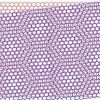-
 +14 +1
+14 +1Small, but mighty: how tiny are nanomaterials and why are they useful?
Nanomaterials have at least one of their dimensions (length, width or height) between 1nm to 100nm (see graphic). In the microscopic nano world, properties such as colour, melting point and electrical conductivity are quite different to their larger, macroscopic counterparts that can be seen with the naked eye.
-
 +22 +1
+22 +1Novel Nanotechnology Could Enhance Effectiveness of Chemo
University of Arizona Health Sciences researchers recently completed a study that has the potential to improve cancer treatment for colorectal cancer and melanoma by using nanotechnology to deliver chemotherapy in a way that makes it more effective against aggressive tumors. The findings were published today in Nature Nanotechnology.
-
 +27 +1
+27 +1Researcher finds a better way to tap into the brain
Using a new class of nanoparticles that are two thousand times thinner than a human hair, Sakhrat Khizroev, a professor of electrical and computer engineering at the University’s College of Engineering, hopes to unlock the secrets of the brain.
-
 +28 +1
+28 +1Nanobots Will Be Flowing Through Your Body by 2030
According to some futurists, in the next 10 or so years, your blood could be streaming with tiny nanorobots to help keep you from getting sick or even transmit your thoughts to a wireless cloud. They will travel inside of you, on a molecular level, protecting your biological system and ensuring that you'll have a good and long life. The future is closer than you may think.
-
 +4 +1
+4 +1Growing gold nanoparticles inside tumors can help kill cancer
Gold isn’t just a pretty face – it’s shown promise in fighting cancer in many studies. Now researchers have found a way to grow gold nanoparticles directly inside cancer cells within 30 minutes, which can help with imaging and even be heated up to kill the tumors.
-
 +4 +1
+4 +1Scientists apply 'twistronics' to light propagation and make a breakthrough discovery
A research team led by scientists at the Advanced Science Research Center at The Graduate Center, CUNY (CUNY ASRC), in collaboration with National University of Singapore, University of Texas at Austin and Monash University, has employed "twistronics" concepts (the science of layering and twisting two-dimensional materials to control their electrical properties) to manipulate the flow of light in extreme ways. The findings, published in the journal Nature, hold the promise for leapfrog advances in a variety of light-driven technologies, including nano-imaging devices; high-speed, low-energy optical computers; and biosensors.
-
 +26 +1
+26 +1Scientists created a new sponge that could clean up oil spills
The secret to cleaning up contaminated water may lie in the cheap, common polyurethane foam used in mattresses. In a study published in the journal Nature Sustainability this week, scientists tested the ability of the material, enhanced with a special coating, to soak up tiny droplets of oil suspended in water. They found that it consistently captured almost all of the oil in under three hours.
-
 +13 +1
+13 +1Researchers observe brain-like behavior in nanoscale device
UCLA scientists James Gimzewski and Adam Stieg are part of an international research team that has taken a significant stride toward the goal of creating thinking machines.
-
 +18 +1
+18 +1Nanomaterials in wastewater have toxic effects on crustaceans and fish
You may not always think about it when you do your laundry or flush the toilet, but whatever you eat, wear or apply on your skin ends up in wastewater and eventually reaches the environment. The use of nanoparticles in consumer products like textiles, foods and personal care products is increasing. What is so special about nanoparticles is their tiny size: One nanometer is one-billionth of a meter.
-
 +2 +1
+2 +1Tiny fluorescent carbon dots could make cancer treatment safer and more effective
A pioneering new technique that could make light-based cancer treatment more effective and safer for patients, while reducing its cost, has been developed by researchers from the University of Sheffield.
-
 +20 +1
+20 +1Graphene discovery could make room-temperature superconductors possible
Scientists have discovered a new kind of graphene material, which researchers estimate could be used to build superconductors that work at room temperature. The breakthrough -- detailed this week in the journal Nature -- occurred when scientists formed moiré patterns with graphene sheets.
-
 +22 +1
+22 +1A new graphene foam stays squishy at the coldest temperatures
Close your eyes and imagine walking along a sandy beach and then gazing over the horizon as the Sun rises. How clear is the image that springs to mind? Most people can readily conjure images inside their head - known as their mind's eye. But this year scientists have described a condition, aphantasia, in which some people are unable to visualise mental images. Niel Kenmuir, from Lancaster, has always had a blind mind's eye. He knew he was different even in childhood. "My stepfather, when I couldn't sleep, told me to count sheep, and he explained what he meant, I tried to do it and I couldn't," he says.
-
 +4 +1
+4 +1Sorry, graphene—borophene is the new wonder material that’s got everyone excited
Not so long ago, graphene was the great new wonder material. A super-strong, atom-thick sheet of carbon “chicken wire,” it can form tubes, balls, and other curious shapes. And because it conducts electricity, materials scientists raised the prospect of a new era of graphene-based computer processing and a lucrative graphene chip industry to boot.
-
 +4 +1
+4 +1Graphene sieve makes seawater drinkable
A UK-based team of researchers has created a graphene-based sieve capable of removing salt from seawater. The sought-after development could aid the millions of people without ready access to clean drinking water. The promising graphene oxide sieve could be highly efficient at filtering salts, and will now be tested against existing desalination membranes. It has previously been difficult to manufacture graphene-based barriers on an industrial scale.
-
 +25 +1
+25 +1What happened to the hyped nanomaterials?
Carbon-based nano materials such as graphene and carbon nanotubes were predicted to have a brilliant future when they were discovered. But quality problems curb the development of new products. The problem is that it is difficult to analyse the crystal structure and there are no established standard methods for classifying the materials. But now, researchers at Karlstad University are close to a solution.
-
 +16 +1
+16 +1Scientists Injected Nanoparticles Into Mice's Eyes to Give Them Infrared Vision
It’s easy to forget it, but much of the world is invisible to us. I don’t mean that in the sense of things being really tiny, or in any metaphorical way. No, most of the world is literally invisible. That’s because what we call visible light is actually a tiny sliver of the much greater electromagnetic spectrum. The rainbow we see sits in the middle of a vast continuum of wavelengths, including everything from high energy gamma and ultraviolet radiation to much lower infrared and radio waves.
-
 +2 +1
+2 +1Scientists Have Developed New Material That is as Flexible as Elastic But Tough as Steel
We may soon have fabrics and clothing that is as stretchy as a rubber band while simultaneously being as durable as steel.
-
 +2 +1
+2 +1Nanoparticles Let Mice See Near Infrared Light
Without night vision goggles, mammals have no hope of seeing infrared light, which has wavelengths longer than light on the visible spectrum. But in a study published today (February 28) in Cell, researchers injected nanoparticles into mouse retinas, giving the rodents the ability to see near-infrared (near-IR) light at about half the resolution of visible light.
-
 +25 +1
+25 +1Artificial Skin Could Help Burn Victims "Feel" Again
University of Connecticut (UConn) scientists say a new type of sensor could lead to artificial skin that someday may help burn victims “feel” again. They described their research (“An Ultra-Shapeable, Smart Sensing Platform Based on a Multimodal Ferrofluid-Infused Surface”) in Advanced Materials. “The development of wearable, all‐in‐one sensors that can simultaneously monitor several hazard conditions in a real‐time fashion imposes the emergent requirement for a smart and stretchable hazard avoidance sensing platform that is stretchable and skin‐like.
-
 +14 +1
+14 +1Healing kidneys with nanotechnology
Each year, there are some 13.3 million new cases of acute kidney injury (AKI), a serious affliction. Formerly known as acute renal failure, the ailment produces a rapid buildup of nitrogenous wastes and decreases urine output, usually within hours or days of disease onset. Severe complications often ensue. Currently, there is no known cure for AKI.
Submit a link
Start a discussion




















